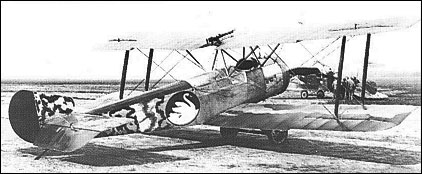|
| Deriving its extraordinary appellation from a characteristic
arrangement of cabane struts - a name that was
initially unofficial, but came to be accepted as a result of
common usage - the 1 1/2-Strutter was both the first
British aircraft to be built with a synchronised gun as
standard equipment and the first true two-seat fighter
to see RFC service. Designed and built for the
Admiralty, the unarmed prototype was completed in
December 1915, and series deliveries to the RNAS followed
from February 1916. A single-bay biplane of
wooden construction with fabric skinning, the
1 1/2-Strutter featured air brakes in the lower wing and
an adjustable-incidence tailplane. At an early production
stage, armament was standardised on a synchronised
7.7mm gun with a second weapon of
similar calibre on a Scarff ring mounting in the rear
cockpit. The 1 1/2-Strutter was used by the RNAS in both
escort and (without observer) bombing roles, and 77 of
the first 150 aircraft ordered by the Admiralty were
transferred to the RFC owing to the exigencies of the
times. A single-seat bomber version of the lVfc-Strutter
was built in parallel, some examples of this variant
being converted as two-seat fighters. Initial production
aircraft were powered by the 110hp Clerget 9Z ninecylinder
rotary engine, but, in the autumn of 1916, this
gave place to a 130hp Clerget 9B. At least 1,513
1 1/2-Strutters were built in the UK (by the parent company,
Fairey Aviation, Hooper & Co, Mann, Egerton &
Co, Ruston, Proctor & Co, Vickers Ltd, Wells Aviation
and Westland Aircraft). The 1 1/2-Strutter was licence-built
in France as a single- and two-seat bomber (SOP
1B1 and 1B2) and two-seat reconnaissance aircraft (SOP
1A2), primarily with the 110hp and 135hp Le Rhone 9J
and 9Jby nine-cylinder rotaries, 4,500 allegedly being
produced by Liore et Olivier, Hanriot, Amiot, Bessoneau, Darracq, REP and Sarazin Freres. The US government
procured 514 from France, and others were supplied
to Belgium and Imperial Russia.
 | A three-view drawing (1278 x 922) |
| WEIGHTS |
| Take-off weight | 975 kg | 2150 lb |
| Empty weight | 592 kg | 1305 lb |
| DIMENSIONS |
| Wingspan | 10.21 m | 34 ft 6 in |
| Length | 7.69 m | 25 ft 3 in |
| Height | 3.12 m | 10 ft 3 in |
| Wing area | 32.14 m2 | 345.95 sq ft |
| PERFORMANCE |
| Max. speed | 161 km/h | 100 mph |
| P JARRETT, e-mail, 01.07.2010 17:26 i am looking for sqn insgnea and colour schemes as used by the french in WW1 any information would be greatly appreciated. reply |
|
Do you have any comments?
|
| 
COMPANY
PROFILE
All the World's Rotorcraft
|







